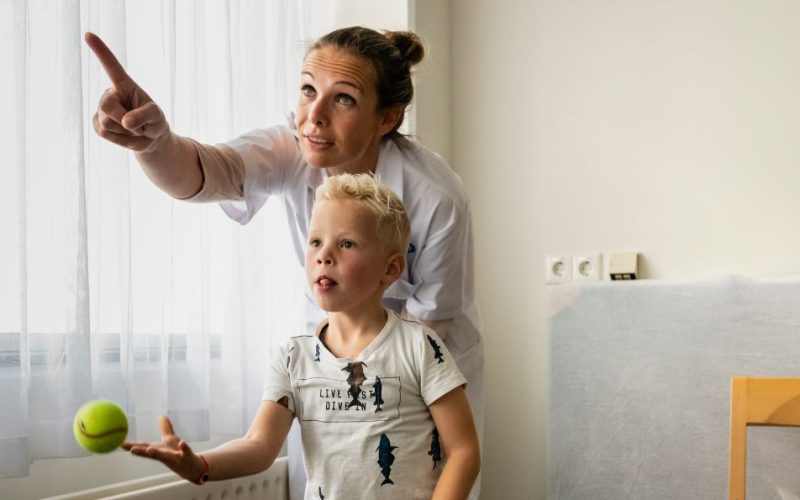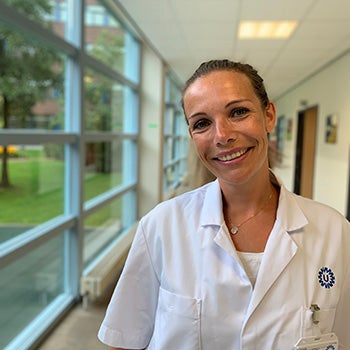Children with severe congenital heart defects sometimes have developmental delays at a young age. To recognize developmental delays as early as possible and respond to them early, the Hart op Weg outpatient clinic was established. Maaike Sprong is a child physiotherapist at the Hart op Weg outpatient clinic and conducts research into the motor development of ‘heart children’.
At the Hart op Weg outpatient clinic several specialists work together, such as neonatologists, pediatric cardiologists, psychologists, pediatric physiotherapists and exercise physiologists. They follow the development of newborns with a severe congenital heart defect until the age of eighteen. At set times before a developmental milestone, children come to the Heart on the Way outpatient clinic. For example, when they start crawling at nine months of age. Or later, when they enter elementary or middle school. At these times, the specialists can recognize developmental delays early and, where possible, support the children in their development, for example, with physical therapy.
Our wish is that children with a congenital heart defect experience as few developmental problems as possible that limit their daily functioning. Therefore, at the WKZ we want to investigate which children are most at risk for problems in motor and physical development. We also want to find out the right time and the right way to improve physical functioning so that they can participate with their peers; in the playground, on the schoolyard and on the sports field. A lot of money is needed for this! Will you help us help these children just be children again? Donate now.
By following heart children from an early age, specialists at the Hart op Weg outpatient clinic are able to collect data on how their development progresses and what developmental delays these children encounter. For example, we now know that many heart children sometimes show a slight delay in their motor development at a young age. Maaike: “For example, children usually start crawling or tucking around nine months. But many heart children do not do that yet. Remarkably, they usually just catch up a few months later without extra help.” When they are three and a half, we also see that their motor skills can lag behind. For example, they cannot hold a pencil properly and find it difficult to aim and catch a ball.
Maaike explains, “The Hart op Weg outpatient clinic has been in existence for about eight years now. We have collected data from about 265 children. Based on this data, we want to investigate which children are most at risk for developmental delay. If it is known which children are at increased risk for motor development delays, we can adjust our care accordingly.
Many heart children have less stamina than their peers around age seven. “This is often not due to the heart itself, but to the endurance of the leg muscles. But we don’t yet know exactly why.” Maaike is investigating whether this is the same group of children who were motorically behind peers at a young age. “If so, we can try to improve motor skills at preschool age already, so that they fit in better with peers and can participate more easily in sports and games,” Maaike says.
Preventing reduced stamina in heart children is important for their continued health. Indeed, young adults with a congenital heart defect who have been less active in their youth have an increased risk of obesity and cardiovascular disease later on. Maaike: “That is why it is so important that these children, like their peers, can play sports and exercise and experience that sports is fun.”
Some 50 years ago, children with congenital heart defects had fewer chances of survival than today. “Today, about seventy percent of them experience hardly any limitations due to the heart defect. The children who do have limitations in their daily lives, we give them the care they need. “We see the children from birth, at intervals until they are eighteen years old. Growing with these children until they are adults makes this a wonderful profession.”
Introductory photo was taken by Sandra Stokmans Photography as part of the #ProjectHartekind & Hartekind Foundation.
Medical factors, the environment the child grows up in, the child’s character, it all plays into how development occurs. Maaike: “That is why it is important that different specialists work together, such as at the Hart op Weg poli. This is the only clinic in the Netherlands where children with a heart defect are followed so closely. In this way, we hope to make a difference for every child.”
The Hart op Weg outpatient clinic is part of the CHD life span study (Congenital Heart Disease); the life span study for children with a congenital heart defect at the WKZ. Within this study, children are followed from the 20-week ultrasound until well into adulthood at fixed points in their lives by various specialists at the WKZ and the UMC Utrecht. By collecting data from all these patients, researchers are gaining ever better insight into the impact of the heart defect on the lives of our patients.

